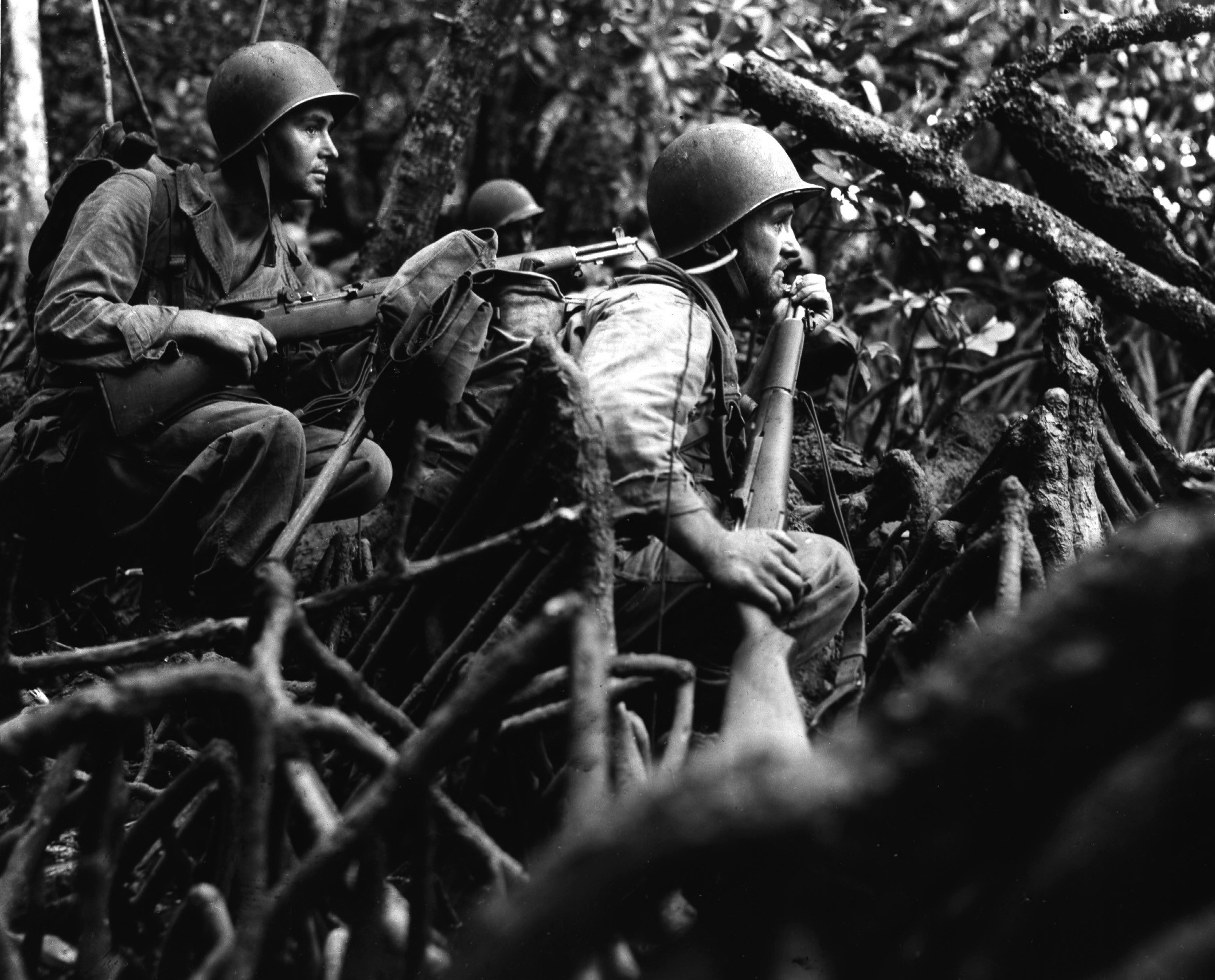Search Results - G.I
G.I.
 GI}}
GI}}G.I. is an informal term that refers to "a soldier in the United States armed forces, especially the army". It is mostly deeply associated with World War II, but continues to see use.
It was originally an initialism used in U.S. Army paperwork for items made of galvanized iron. The earliest known instance in writing is from either 1906 or 1907.
During World War I, U.S. soldiers took to referring to heavy German artillery shells as "G.I. cans". During the same war, "G.I.", reinterpreted as "government issue" or "general issue", began being used to refer to any item associated with the U.S. Army, ''e.g.'', "G.I. soap". Other reinterpretations of "G.I." include "garrison issue" and "general infantry".
The earliest known recorded instances of "G.I." being used to refer to an American enlisted man as a slang term are from 1935. In the form of "G.I. Joe" it was made better known due to it being taken as the title of a comic strip by Dave Breger in ''Yank, the Army Weekly'', beginning in 1942. A 1944 radio drama, ''They Call Me Joe'', reached a much broader audience. It featured a different individual each week, thereby emphasizing that "G.I. Joe" encompassed U.S. soldiers of all ethnicities. ''They Call Me Joe'' reached civilians across the U.S. via the NBC Radio Network and U.S. soldiers via the Armed Forces Radio Network.
"G.I. Jane" originally referred to a member of the Women's Army Corps during World War II, but more recently it is used to refer to any American woman soldier.
In British military parlance and in armed forces modelled on British military traditions, G.I. refers to a Gunnery Instructor, generally an NCO responsible for inducting and training recruits. Provided by Wikipedia
- Showing 1 - 20 results of 25
- Go to Next Page
-
1
Economic Co-Operation Between The U.S.S.R. And Turkey / G. I. Sosnov. by Sosnov, G. I.
Published 1991Call Number: Loading…
Located: Loading…Book Loading… -
2
Grolier Computer Sciences Library.
Published 1977“…G.I…”
Call Number: Loading…
Located: Loading…Book Loading… -
3
Global Rekabet Ortamı Karşısında Yeni Bir Sanayileşme Modeli / Haz. Metin Göker.
Published 1992“…T.G.İ.D…”
Call Number: Loading…
Located: Loading…Book Loading… -
4
2000'Li Yıllara Doğru Türkiye'Nin Önde Gelen Sorunlarına Yaklaşımlar: 22-Ulaştırma.
Published 1997“…T.G.İ.D…”
Call Number: Loading…
Located: Loading…Book Loading… -
5
2000'Li Yıllara Doğru Türkiye'Nin Önde Gelen Sorunlarına Yaklaşımlar: 24-Tüketicinin Korunması / Haz. Engin Başaran.
Published 1997“…T.G.İ.D…”
Call Number: Loading…
Located: Loading…Book Loading… -
6
1992 Yılı Başında Türkiye Ekonomisi Ve Beklentiler / Temel Ergun, İlkin Baray. by Ergun, Temel
Published 1992“…E.G.İ.A.D…”
Call Number: Loading…
Located: Loading…Book Loading… -
7
Türkiye'de karayolları nakliyat idaresi 1960. Tercüme eden Orhan Sungur. by Ireland, Geoffrey
Published 1961Call Number: Loading…
Located: Loading…Book Loading… -
8
Çalışanların İş Doyumu Üzerine Bir İnceleme / Gülten İncir. by İncir, Gülten
Published 1990Call Number: Loading…
Located: Loading…Book Loading… -
9
The economics of the modern construction sector / Graham J. Ive, and Stephen Gruneberg. by Ive, Graham
Published 2000Call Number: Loading…
Located: Loading…Book Loading… -
10
Ergonomi: çalışma ortamı ve fiziksel çevre: gürültü titreşim aydınlatma hava koşulları / Gülten İncir. by İncir, Gülten
Published 2008Call Number: Loading…
Located: Loading…Book Loading… -
11
Explanatory note on the 1967 input - output study for the use in the TFYP model / Güler İzmirlioğlu by İzmirlioğlu, Güler
Published 1972Call Number: Loading…
Located: Loading…Conference Proceeding Loading… -
12
Türkiye'De Kütüphane Otomasyonu Ve Sorunları / Gülsema İlhan. by İlhan, Gülsema
Published 1988Call Number: Loading…
Located: Loading…Book Loading… -
13
Çocuk suç ve sokak: sokakta yaşayan, suç işleyen ve suça maruz kalan çocuklar: Ankara ve İstanbul örneği, çözümler ve öneriler / Tülin Günşen İçli; haz. : Sadık Güneş.... by İçli, Tülin Günşen
Published 2009Call Number: Loading…E-ERİŞİM
Located: Loading…
Book -
14
Türkiye'de suçlular: sosyal, kültürel ve ekonomik özellikleri / Tülin Günşen İçli. by İçli, Tülin Günşen
Published 1993Call Number: Loading…
Located: Loading…Book Loading… -
15
Kentleşme ve çevre sorunları.4. Eyüp G. İsbir, Bülent Açma (Derl.):Bülent Açma by İsbir, Eyüp G.
Published 2001Call Number: Loading…
Located: Loading…Book Loading… -
16
Kentleşme, Metropolitan Alan Ve Yönetimi / Eyüp G. İsbir. by İsbir, Eyüp G.
Published 1982Call Number: Loading…
Located: Loading…Book Loading… -
17
Türkiye'de devlet memurlarının denetimi. by İsbir, Eyüp G
Published 1977Call Number: Loading…
Located: Loading…Book Loading… -
18
Management by objectives and results. by Morrisey, George I
Published 1970Call Number: Loading…
Located: Loading…Book Loading… -
19
Çocuk Cinsiyeti Nedeniyle Kadın Üzerinde Oluşturulan Psikolojik Şiddet, Başlık Parası ve Geleneksel Evlilikler Hakkında Komisyon raporu / TBMM Kadın Erkek Fırsat Eşitliği Komisyonu...
Published 2011Call Number: Loading…
Located: Loading…Book Loading… -
20
İşyerinde Psikolojik Taciz (mobbing) ve Çözüm Önerileri Komisyon raporu / TBMM Kadın Erkek Fırsat Eşitliği Komisyonu; Haz. : Gökalp İzmir, Aygül Fazlıoğlu.
Published 2010Call Number: Loading…
Located: Loading…Book Loading…
Search Tools:
Related Subjects
Türkiye
Contracting out
Kentleşme
Personnel management
Privatization
Ulaştırma
Özelleştirme
Basıc (B.P.D.)
Bullying in the workplace
Bureaucracy
Bus lines
Bürokrasi
Case studies
Cinsiyet ayrımcılığı kadınlara karşı
Civil service
Cobol (B.P.D.)
Construction industry
Crime
Criminals
Dış Ekonomik İlişki
Dış Ekonomik İlişkiler
Dış hizmet alımı
Dışarıyla yapılan sözleşme
Econometric models
Economic aspects
Economic planning
Ekonometrik modeller
Ekonomik Durum
Ekonomik planlama
Ekonomik yönü
